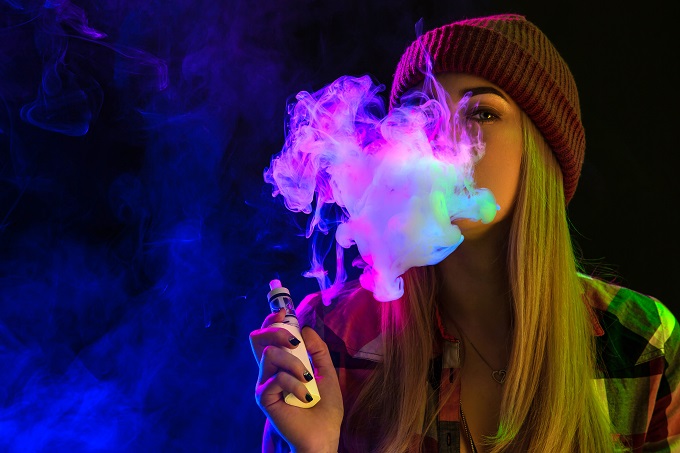Staving off the teen vaping epidemic

Bart Simpson walks into the Kwik-E-Mart to buy an e-cigarette.
Apu warns: “Remember, this is not kid’s stuff! Now, would you like bubble-gum flavour, strawberry shortcake or watermelon dream?”
This brief scene in The Simpsons went viral for poking fun at an industry that has become an epidemic in America: teen vaping.
This is an exclusive from our Term 3 magazine issue. Check out the full edition here!
Teenagers in this country are also catching on despite Australia’s much tougher regulations and many are now calling for schools to get ahead of the trend. Trying to find out what schools should be doing, we spoke to Cancer Council CEO and professor Sanchia Aranda, as well as a high school principal, one former teen vaper, and a couple of education experts.
What is vaping?
Vaping is the colloquial term for ‘smoking’ e-cigs, or electronic cigarettes. They are battery-powered devices that vaporise liquid; originally, they were designed as an alternative to smoking tobacco cigarettes. The draw for smokers was that the ritual and behaviour of smoking can be replicated in vaping nicotine-containing e-liquids. But e-cigs have found a new audience in young people looking for a new way to flex on Snapchat.
‘JUULing’ is a term used frequently by young people to describe vaping. JUUL is a brand of e-cigs that has gained popularity among high school students in particular because the devices look deceptively like USB sticks and can go unnoticed by parents and teachers. They have become such a problem in the US that JUUL CEO Kevin Burns apologised to parents. “I’m sorry,” he told CNBC reporter Carl Quintanilla, “I hope there was nothing that we did that made it appealing to them.” The company has shut-down its social media accounts and pulled some of its fruitier flavours.
In just one year, the number of US high school students using e-cigarettes shot up by 78 percent; rising to 3.6 million in 2018 from 2.1 million in 2017, according to a survey by the Centers for Disease Control and Prevention. The numbers prompted CDC director Robert Redfield to warn: “The skyrocketing growth of young people’s e-cigarette use over the past year threatens to erase progress made in reducing youth tobacco use. It’s putting a new generation at risk for nicotine addiction.”
Why is Australia different?
Australia has strict regulations in place for nicotine-containing products, which is why Professor Aranda says “we are no-where near [the US] level with nicotine-containing e-cigs” but it’s a different story for e-liquids marketed as nicotine-free. She continued: “We are very concerned about the health impact of flavoured materials and want to see more health research on those products.”
Professor Aranda explained that in Australia, nicotine-containing e-cig products are illegal without a prescription and with a prescription they have to be bought from overseas because Australian companies can’t demonstrate safety data and therefore can’t make a submission to sell the products in this country. “But,” she added, “flavoured nicotine-free vapes are unregulated”. This means there is no specification about what ingredients can or can’t be in nicotine-free e-liquids
Australian researchers from the Telethon Kids Institute recently found that six out of 10 varieties of supposedly ‘nicotine-free’ e-liquids actually contained nicotine when tested. Some samples also contained a known toxic chemical, called 2-chlorophenol. “We also found other things, by-products of animal or human bodily functions, which indicates the process of making the e-liquids might not be as clean as you might hope,” Associate Professor Alex Larcombe told ABC on behalf of his research team.
Teens are not allowed to
purchase e-cigs, but they do
While under-18s are not allowed to purchase any type of e-cigarette or vaping product in Australia, teenagers can find ways to import them online. One young man from Queensland told us he purchased his first vape online when he was 16 years’ old. “I was the coolest kid in my grade for about three weeks, until my parents found out and confiscated it,” he said. He chose a watermelon flavoured e-liquid and thought the vapour “was literally just water”.
This seems to be a common misconception from teenagers about e-cigs and one that schools could clear up with their students by sharing research findings. As Professor Aranda warned, e-liquids can contain things like heavy metals and formaldehyde, so “it’s not harmless water”. At the same time, the branding of e-cigs and e-vapours tend to attract young people. Professor Aranda said she has even seen flavours that mimic the branding of a popular doughnut retailer, “so kids can inhale their favourite donut – it’s insane”.
Not enough research
on health risks
Because these devices represent a new technology, there aren’t any truly long-term studies that can definitively demonstrate health benefits or risks. Many ex-smokers who have turned to e-cigs frequently claim health benefits; however there are no substantial studies to prove whether this is true. According to the Australian Alcohol and Drug Foundation, “there is very little available research that indicates if e-cigarettes can help people quit smoking as the results of studies on individual brands vary”.
“Their effectiveness in helping people give up tobacco can only be assessed by the Therapeutic Goods Administration (TGA), which to date has not occurred.” The Foundation expressed concern that smokers may simply become dual users of both cigarettes and e-cigs.
In July this year, the Wisconsin Department of Health Services said it had opened an investigation after 11 teenagers and young people were hospitalised with severe lung damage after vaping.
Professor Aranda said that in Australia, less than five percent of regular smokers are teenagers, “so vaping as a gateway could pose more problems than solutions”.
“There’s a myth that e-cigs are 95 percent safer than cigarettes that was based on a guesstimate by 12 individuals and was never substantiated – WHO has discredited it.
“We need longitudinal studies and we don’t know whether inhaling [e-liquid] is better. We would like schools to be much more proactive on educating students on the gateway effects; how they are more likely to move on to cigarettes and explain why Australia has had a more precautionary approach.”
What should schools do?
Including e-cigarettes in your school’s alcohol and drug education program would be a good place to start; particularly as one of the reasons teenagers gravitate towards ‘vaping’ is that they believe it is a safe alternative to smoking. Schools can also open a conversation with parents about e-cig devices: explain what they look like, how students are able to purchase them online and why they should be wary of health concerns.
Moriah College recently took this initiative, addressing the issue by writing to parents. Head of high school, Jan Hart told us: “Given the relative newness of vaping, it’s a topic that many of us don’t know much about. We had extremely positive feedback,” she said, noting that parents appreciated being kept up-to-date. The school’s public letter made it clear that students could be suspended if they “possess, smoke, consume, use, or deal in tobacco, e-cigarettes, prohibited drugs, alcohol or assist another person to obtain, consume, use, or deal in such substances, on College premises”.
Education expert and chief learning officer at Cluey Learning, Dr Selina Samuels said: “Educating teens on the risks of vaping (and, of course, smoking) should be a common part of the health curriculum.
“Even with the lack of consensus, it is important that schools take a conservative approach to anything that could compromise the health of their students.”
Being sceptical
Schools could demonstrate the differences between Australian and international media as part of their approach to e-cig education so that students know how to be critical of the ways vaping is portrayed by celebrities and in popular media.
Depictions of teen e-cig use are becoming more common, with the latest example in HBO’s controversial new high school drama, Euphoria which is currently airing as MA15+ on Foxtel. Even though Australia tightly regulates its media codes of practice, teenagers are exposed to more international media than ever through streaming and regulations frequently differ in international markets. It means there’s a possibility that trends from overseas can be normalised and adopted at home.
Staying proactive can help make sure the teen vaping epidemic doesn’t take root here in Australia.






